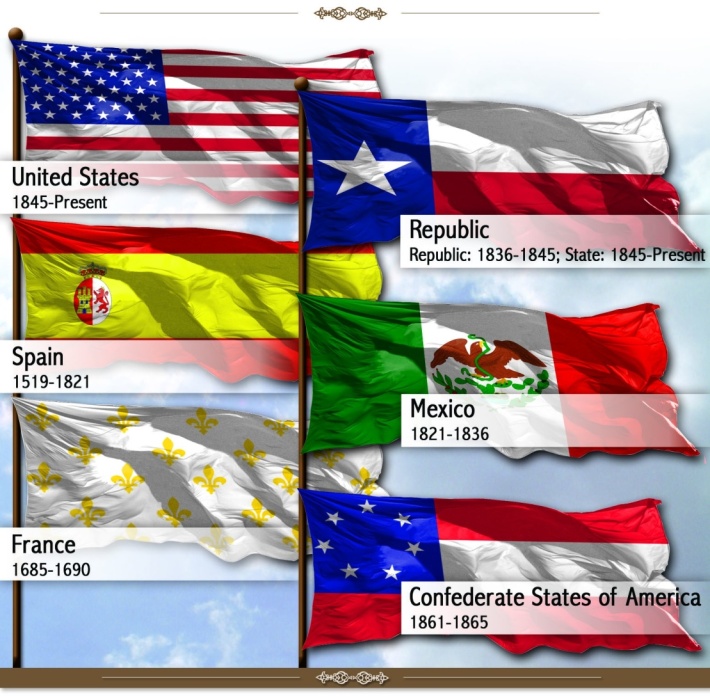
Texas often is called the Lone Star State because of its state flag with a single star. This was also the flag of the Republic of Texas. The information about historic Texas flags, the current flag and other Texas symbols may be supplemented by information available from the Texas State Library.
Pledge to the Texas Flag
A pledge to the Texas flag was adopted by the 43rd Legislature. It contained a phrase, “Flag of 1836,” which inadvertently referred to the David G. Burnet flag instead of the Lone Star Flag adopted in 1839. In 2007, the 80th Legislature changed the pledge to its current form:
“Honor the Texas flag; I pledge allegiance to thee, Texas,
one state under God, one and indivisible.”
A person reciting the pledge to the state flag should face the flag, place the right hand over the heart and remove any easily removable hat. The pledge to the Texas flag may be recited at all public and private meetings at which the pledge of allegiance to the national flag is recited and at state historical events and celebrations. The pledge to the Texas flag should be recited after the pledge of allegiance to the United States flag if both are recited.
Click here to purchase a TEXAS FLAG
Come and Take It Flag

In early January 1831, Green DeWitt wrote to Ramón Músquiz, the top political official of Bexar, and requested armament for defence of the colony of Gonzales. This request was granted by delivery of a small used cannon. The small bronze cannon was received by the colony and signed for on March 10, 1831, by James Tumlinson, Jr.The swivel cannon was mounted to a blockhouse in Gonzales, Texas and later was the object of Texas pride. At the minor skirmish known as the Battle of Gonzales—the first battle of the Texas Revolution against Mexico—a small group of Texians successfully resisted the Mexican forces who had orders from Col. Domingo de Ugartechea to seize their cannon. As a symbol of defiance, the Texians had fashioned a flag containing the phrase “come and take it” along with a black star and an image of the cannon which they had received six years earlier from Mexican officials—this was the same message that was sent to the Mexican government when they told the Texans that they had to return their cannon—failure to comply with the Mexican’s original demands led to the failed attempt by the Mexican military to forcefully take back the cannon.
Replicas of the original flag can be seen in the Texas State Capitol, the University of Texas at El Paso Library, the Marine Military Academy headquarters building, the Hockaday School Hoblitzelle Auditorium, and in Perkins Library at Duke University.
Click here to purchase a Come and Take It Flag
State Song
The state song of Texas is “Texas, Our Texas.” The music was written by the late William J. Marsh (who died Feb. 1, 1971, in Fort Worth at age 90), and the words by Marsh and Gladys Yoakum Wright, also of Fort Worth. It was the winner of a state song contest sponsored by the legislature and was adopted in 1929. The wording has been changed once: Shortly after Alaska became a state in Jan. 1959, the word “Largest” in the third line was changed by Mr. Marsh to “Boldest.” The text follows:
Texas, Our Texas
Texas, our Texas! all hail the mighty State!
Texas, our Texas! So wonderful, so great!
Boldest and grandest, Withstanding ev’ry test;
O Empire wide and glorious, You stand supremely blest.
Chorus
God bless you, Texas!
And keep you brave and strong,
That you may grow in power and worth,
Thro’out the ages long.
Refrain
Texas, O Texas! Your freeborn Single Star,
Sends out its radiance To nations near and far.
Emblem of freedom! It sets our hearts aglow,
With thoughts of San Jacinto And glorious Alamo.
Texas, dear Texas! From tyrant grip now free,
Shines forth in splendor Your Star of Destiny!
Mother of Heroes! We come your children true,
Proclaiming our allegiance, Our Faith, Our Love for you.
Click here for an MP3 of Texas, Our Texas
State Motto
The state motto of Texas is “Friendship.” The word, Texas, or Tejas, was the Spanish pronunciation of a Caddo Indian word meaning “friends” or “allies.” (Acts of 1930, fourth called session of the 41st Legislature, p. 105.)
State Citizenship Designation
The people of Texas usually call themselves Texans. However, Texian was generally used in the early period of the state’s history.
Texas State Symbols
| Mockingbird. |
State Bird
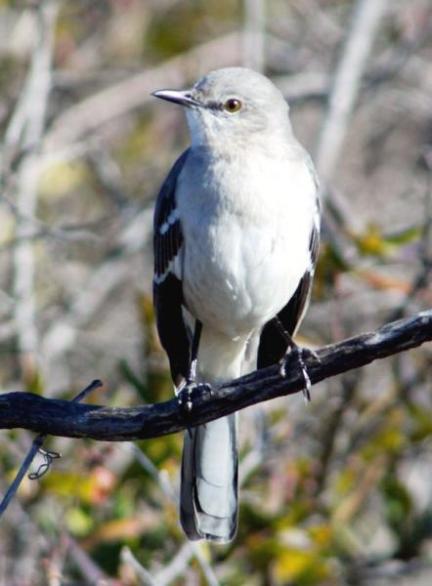
The mockingbird (Mimus polyglottos) is the state bird of Texas, adopted by the 40th Legislature of 1927 at the request of the Texas Federation of Women’s Clubs.
| Bluebonnet. |
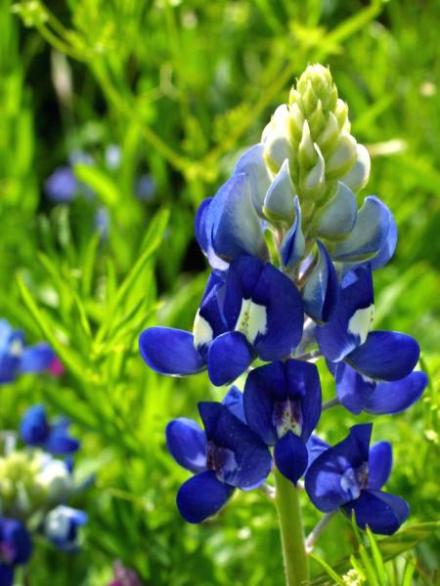
State Flower
The state flower of Texas is the bluebonnet, also sometimes called buffalo clover, wolf flower and el conejo (the rabbit). The bluebonnet was adopted as the state flower, at the request of the Society of Colonial Dames in Texas, by the 27th Legislature in 1901. The original resolution designated Lupinus subcarnosus as the state flower, but a resolution by the 62nd Legislature in 1971 provided legal status as the state flower of Texas for “ Lupinus Texensis and any other variety of bluebonnet.”
Click here for Bluebonnet Seeds
| Pecan tree. |

State Tree
The pecan tree (Carya illinoinensis) is the state tree of Texas. The sentiment that led to its official adoption probably grew out of the request of Gov. James Stephen Hogg that a pecan tree be planted at his grave. The 36th Legislature in 1919 adopted the pecan tree.
Other Symbols
(In 2001, the Legislature placed restrictions on the adoption of future symbols by requiring that a joint resolution to designate a symbol must specify the item’s historical or cultural significance to the state.)
State Air Force
The Commemorative Air Force, based in Midland at Midland International Airport, was proclaimed the state air force of Texas by the 71st Legislature in 1989.
State Amphibian
The Texas toad was named the state amphibian of Texas by the 81st Legislature in 2009.
State Bread
Pan de campo, translated “camp bread” and often called cowboy bread, was named the state bread by the 79th Legislature in 2005. It is a simple baking-powder bread that was a staple of early Texans and often baked in a Dutch oven.
State Cooking Implement
| A Dutch oven. |

The cast iron Dutch oven was named the cooking implement of Texas by the 79th Legislature in 2005.
Click here for a Dutch Oven
State Dinosaur
The Paluxysaurus jonesi, was designated the state dinosaur by the 81th Legislature in 2009.
State Dish

Chili was proclaimed the Texas state dish by the 65th Legislature in 1977.
Click here for the best Texas Chili Mix available
| Blue Lacy. |

State Dog Breed
The Blue Lacy was designated the state dog breed by the 79th Legislature in 2005. The Blue Lacy is a herding and hunting breed descended from greyhound, scent-hound, and coyote stock and developed by the Lacy brothers, who left Kentucky and settled near Marble Falls in 1858.
State Epic Poem
“The Legend of Old Stone Ranch,” written by John Worth Cloud, was named the epic poem of Texas by the 61st Legislature in 1969. The work is a 400-page history of the Albany–Fort Griffin area written in verse form.
Click here for “The Legend of Old Stone Ranch”
State Fiber and Fabric
Cotton was designated the state fiber and fabric by the 75th Legislature in 1997.
| Guadalupe bass. |
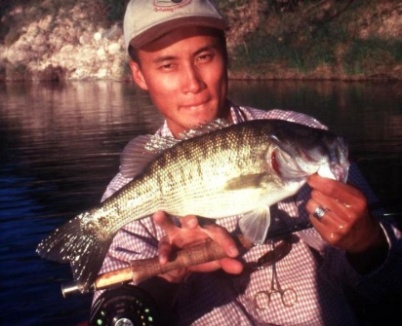
State Fish
The Guadalupe bass, a member of the genus Micropterus within the sunfish family, was named the state fish of Texas by the 71st Legislature in 1989. It is one of a group of fish collectively known as black bass.
State Flower Song
“Bluebonnets,” written by Julia D. Booth and Lora C. Crockett, was named the state flower song by the 43rd Legislature in 1933.
State Folk Dance
The square dance was designated the state folk dance by the 72nd Legislature in 1991.
State Fruit
The Texas red grapefruit was designated the state fruit by the 73rd Legislature in 1993.
State Gem
 |
| Lone Star Cut. |
Texas blue topaz, the state gem of Texas, is found in the Llano uplift area in Central Texas, especially west to northwest of Mason. It was designated by the 61st Legislature in 1969.
State Gemstone Cut
The Lone Star Cut was named the state gemstone cut by the 65th Legislature in 1977.
State Grass
 |
| Sideoats grama. |
Sideoats grama (Bouteloua curtipendula), a native grass found on many different soils, was designated the state grass of Texas by the 62nd Legislature in 1971.
State Health Nut
The pecan was designated the state nut by the 77th Legislature in 2001.
State Horse
The American Quarter Horse was named the state horse by the 81st Legislature in 2009.
State Insect
The Monarch butterfly (Danaus plexippus) was designated the state insect by the 74th Legislature in 1995.
State Mammals
The armadillo (Dasypus novemcinctus) was designated the state small mammal; the longhorn was designated the state large mammal; and the Mexican free-tailed bat (Tadarida brasiliensis) was designated the state flying mammal by the 74th Legislature in 1995.
State Music
Western swing was named the state’s official music by the 82nd Legislature in 2011.
State Musical Instrument
The guitar was named the state musical instrument by the 75th Legislature in 1997.
State Native Pepper
The chiltepin was named the native pepper of Texas by the 75th Legislature in 1997.
Click here for chiltepin pepper seeds.
State Native Shrub
The Texas purple sage (Leucophyllum frutescens) was designated the state native shrub by the 79th Legislature in 2005.
State Pepper
The jalapeño pepper was designated the state pepper by the 74th Legislature in 1995.
State Plant
| Prickly pear cactus. |

The prickly pear cactus was named the state plant by the 74th Legislature in 1995.
State Plays
The four official state plays of Texas are The Lone Star, Texas, Beyond the Sundown, and Fandangle. They were designated by the 66th Legislature in 1979.
State Railroad
The Texas State Railroad was designated the state railroad by the 78th Legislature in 2003. It is a steam powered tourist excursion train that runs between the towns of Rusk and Palestine.
State Reptile
The Texas horned lizard (Phrynosoma cornutum) was named the state reptile by the 73rd Legislature in 1993.
State Seashell
The lightning whelk (Busycon perversum pulleyi) was named the official state seashell by the 70th Legislature in 1987. One of the few shells that open on the left side, the lightning whelk is named for its colored stripes. It is found on the Gulf Coast.
State Ship
| Battleship Texas. |
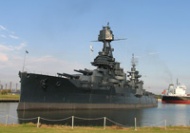
The battleship USS Texas was designated the state ship by the 74th Legislature in 1995. The USS Texas was launched on May 18, 1912, from Newport News, Va., and commissioned on March 12, 1914. In 1919, it became the first U.S. battleship to launch an aircraft, and in 1939 it received the first commercial radar in the U.S. Navy. It participated in both World Wars I and II. In 1940, the Texas was designated flagship of the U.S. Atlantic Fleet. It was decommissioned on April 21, 1948, and is a National Historic Landmark and a National Mechanical Engineering Landmark. It is at the San Jacinto Battleground near Houston.
State Shrub
The crape myrtle (Lagerstroemia indica) was designated the official state shrub by the 75th Legislature in 1997.
State Snack
Tortilla chips and salsa was designated the official state snack by the 78th Legislature in 2003 at the request of second-grade students in Mission.
State Sport
Rodeo was named the state sport of Texas by the 75th Legislature in 1997.
State Stone
Petrified palmwood, found in Texas principally in eastern counties near the Texas Gulf Coast, was designated the state stone by the 61st Legislature in 1969.
State Tall Ship
The Elissa was named the state tall ship by the 79th Legislature in 2005. The 1877 ship makes its home at the Texas Seaport Museum at the port of Galveston.
State Tartan
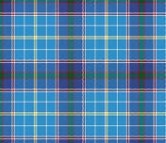 |
| Texas Bluebonnet Tartan. |
The Texas Bluebonnet Tartan was named the official state tartan by the 71st Texas Legislature in 1989.
State Vegetable
The Texas sweet onion was designated the state vegetable by the 75th Legislature in 1997.
Click here for Texas Sweet Onion Seeds
State Vehicle
The chuck wagon was named the state vehicle by the 79th Legislature in 2005. Texas rancher Charles Goodnight is credited with inventing the chuck wagon to carry cowboys’ food and supplies on trail drives.
State 10K
The Texas Roundup 10K, held each April in Austin, was named the state ten kilometer run by the 79th Legislature in 2005 to encourage Texans to exercise and incorporate physical activity into their daily lives.
49 Random Facts about Texas:
- Texas is popularly known as The Lone Star State.
- The Alamo is located in San Antonio. It is where Texas defenders fell to Mexican General Santa Anna and the phrase Remember the Alamo originated. The Alamo is considered the cradle of Texas liberty and the state’s most popular historic site.
- The lightning whelk is the official state shell.
- Texas is the only state to have the flags of 6 different nations fly over it. They are: Spain, France, Mexico, Republic of Texas, Confederate States, and the United States.
- Although six flags have flown over Texas, there have been eight changes of government: Spanish 1519-1685, French 1685-1690, Spanish 1690-1821, Mexican 1821-1836, Republic of Texas 1836-1845, United States 1845-1861, Confederate States 1861-1865, United States 1865-present
- The King Ranch in Texas is bigger than the state of Rhode Island.
- During the period of July 24-26, 1979, the Tropical Storm Claudette brought 45 inches of rain to an area near Alvin, Texas, contributing to more than $600 million in damages. Claudette produced the United States 24 hour rainfall record of 43 inches.
- More wool comes from the state of Texas than any other state in the United States.
- Edwards Plateau in west central Texas is the top sheep growing area in the country.
- Texas is the only state to enter the United States by treaty instead of territorial annexation.
- The state was an independent nation from 1836 to 1845.
- Texas boasts the nation’s largest herd of whitetail deer.
- A coastal live oak located near Fulton is the oldest tree in the state. The tree has an estimated age of more than 1,500 years.
- Sam Houston, arguably the most famous Texan, was actually born in Virginia. Houston served as governor of Tennessee before coming to Texas.
- Caddo Lake is the only natural lake in the state.
- The first offensive action of the Texas Revolution occurred in Goliad on October 9, 1835 when local colonists captured the fort and town.
- On December 20, 1835 the first Declaration of Texas Independence was signed in Goliad and the first flag of Texas Independence was hoisted.
- The Hertzberg Circus Museum in San Antonio contains one of the largest assortments of circusana in the world.
- The capital city of Austin is located on the Colorado River in south-central Texas. The capitol building is made from Texas pink granite. It served as the capital of the Republic of Texas in 1840-1842.
- Austin is considered the live music capital of the world.
- Texas is home to Dell and Compaq computers and central Texas is often referred to as the Silicon Valley of the south.
- Professional sports teams include the Dallas Cowboys, Dallas Mavericks, Dallas Stars, Houston Astros, Houston Texans, Houston Comets, Houston Rockets, San Antonio Spurs, and Texas Rangers.
- Dr Pepper was invented in Waco in 1885. The Dublin Dr Pepper, 85 miles west of Waco, still uses pure imperial cane sugar in its product. There is no period after the Dr in Dr Pepper.
- The first suspension bridge in the United States was the Waco Bridge. Built in 1870 and still in use today as a pedestrian crossing of the Brazos River.
- In 1836 five sites served as temporary capitals of Texas: Washington-on-the-Brazos: Harrisburg: Galveston: Velasco: and Columbia. Sam Houston moved the capital to Houston in 1837. In 1839 the capital was moved to the new town of Austin.
- The capitol in Austin opened May 16, 1888. The dome of the building stands seven feet higher than that of the nation’s Capitol in Washington, D.C.
- Texas comes from the Hasinai Indian word tejas meaning friends or allies.
- The armadillo is the official state mammal.
- Texas has the first domed stadium in the country. The structure was built in Houston and opened in April 1965.
- The Houston Comets are the only team in the country to win four back-to-back WNBA championships. 1997-2000 Cynthia Cooper remains the only player to win the WNBA Championship MVP.
- The worst natural disaster in United States history was caused by a hurricane that hit Galveston in 1900. Over 8000 deaths were recorded.
- The first word spoken from the moon on July 20, 1969 was Houston.
- Texas’ largest county is Brewster with 6,208 square miles.
- Texas possesses three of the top ten most populous cities in the United States. These towns are Houston, Dallas, and San Antonio.
- El Paso is closer to Needles, California than it is to Dallas.
- Texas includes 267,339 square miles, or 7.4% of the nation’s total area.
- The state’s cattle population is estimated to be near 16 million.
- More land is farmed in Texas than in any other state.
- More species of bats live in Texas than in any other part of the United States.
- Laredo is the world’s largest inland port.
- Port Lavaca has the world’s longest fishing pier. Originally part of the causeway connecting the two sides of Lavaca Bay, the center span of was destroyed by Hurricane Carla in 1961.
- The Tyler Municipal Rose Garden is the world’s largest rose garden. It contains 38,000 rose bushes representing 500 varieties of roses set in a 22-acre garden.
- Amarillo has the world’s largest helium well.
- The world’s first rodeo was held in Pecos on July 4, 1883.
- The Flagship Hotel on Seawall Boulevard in Galveston is the only hotel in North America built entirely over the water.
- The Heisman trophy is named for John William Heisman the first full-time coach and athletic director at Rice University in Houston.
- Brazoria County has more species of birds than any other comparable area in North America.
- The Aransas Wildlife Refuge is the winter home of North America’s only remaining flock of whooping cranes.
- Jalapeno pepper jelly originated in Lake Jackson and was first marketed in 1978. (Jalapeno Jelly available here)
*This blog was sourced from various places on the internet. I tried to verify through multiple sources, but there may be some innacuracies, even though I did try to ensure 100% precision.

